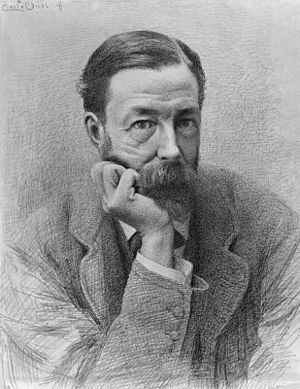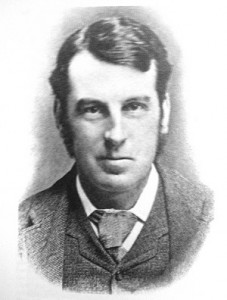John Addington Symonds facts for kids
John Addington Symonds Jr. (born October 5, 1840 – died April 19, 1893) was an English poet and writer. He was also a historian who studied culture, especially known for his work on the Renaissance. He wrote many biographies about famous writers and artists.


Contents
Early Life and Education
Symonds was born in Bristol, England, in 1840. His father, John Addington Symonds, was a doctor and a writer. Young John was thought to be quite delicate and didn't play many games at Harrow School after he turned 14. He didn't show much special talent for schoolwork at first.
When he was ten, Symonds moved to Clifton Hill House. He felt this move really helped his health and personal growth. He continued to be delicate and sometimes had scary nightmares. Once, he almost drowned while sleepwalking in the attic. He believed an "angel" woke him up and saved him.
In 1858, Symonds went to Balliol College at Oxford University. He quickly showed his academic skills. In 1860, he earned top marks and won a special poetry prize for his poem about "The Escorial". He continued to excel, earning more awards in 1862 and 1863 for his studies and essays.
In 1862, Symonds became a fellow at Magdalen College. He became friends with a student named C. G. H. Shorting, whom he tutored. An accusation was made against Symonds, which caused him a lot of stress. Even though he was officially cleared of any wrongdoing, he suffered a breakdown and soon left the university for Switzerland.
Family Life
While in Switzerland, John Addington Symonds met Janet Catherine North. She was the sister of the famous botanical artist Marianne North. They got married in Hastings on November 10, 1864.
The couple settled in London and had four daughters: Janet (born 1865), Charlotte (born 1867), Margaret (Madge) (born 1869), and Katharine (born 1875). Katharine later became known for her writing and was honored as Dame Katharine Furse. The famous writer Edward Lear even wrote his poem "The Owl and the Pussycat" for their three-year-old daughter, Janet.
In 1868, while living in Clifton, Symonds met Norman Moor, a young man who was about to start at Oxford. Norman became Symonds's student.
Writing Career
Symonds had planned to study law, but his health issues meant he had to travel instead. When he returned to Clifton, he gave lectures at the college and at schools for girls. From these lectures, he wrote essays that became his books Introduction to the Study of Dante (1872) and Studies of the Greek Poets (1873–1876).
His most important work was Renaissance in Italy, which came out in seven books between 1875 and 1886. Symonds had wanted to study the Renaissance since his time at Oxford. He wanted to show how art and literature came back to life in Europe during this period. His work was stopped by a serious illness in 1877, which put his life in danger.
He recovered in Davos Platz, Switzerland, and felt that this was the only place where he could truly enjoy life. He made Davos his home, writing about it in Our Life in the Swiss Highlands (1891). Symonds became a citizen of the town, helped with local business, and became friends with the people living there.
Most of his books were written in Davos. These included biographies of famous people like Percy Bysshe Shelley (1878), Philip Sidney (1886), Ben Jonson (1886), and Michelangelo (1893). He also wrote several poetry books and essays, and translated the Autobiography of Benvenuto Cellini (1887).
In Davos, he finished his major study of the Renaissance, which is what he is best remembered for. He was incredibly busy throughout his life. Even with his poor health, he wrote a remarkable amount. Two of his works, a book of essays called In the Key of Blue and a study of Walt Whitman, were published in the year he died. He kept working right up until the end of his life.
Symonds loved Italy very much. For many years, he spent his autumns at the home of his friend, Horatio F. Brown, in Venice. He died in Rome and was buried near the grave of Percy Bysshe Shelley.
Legacy and Writing Style
After Symonds died, he left his papers and his life story with his friend Horatio F. Brown. Brown wrote a biography about him in 1895. Later, some of Symonds's papers were destroyed by another writer, which upset his granddaughter.
Symonds was a deep thinker, often looking inward, but he was also capable of action. The writer Robert Louis Stevenson described Symonds as a wonderful talker. He said Symonds would praise the earth, arts, flowers, jewels, wine, and music in a "moonlight, serenading manner." But beneath his friendly nature, he was often sad.
This sad side of him can be seen in his thoughtful poetry, especially in the sonnets of his book Animi Figura (1882). He described his own character very carefully in his writing. His poetry might seem more like that of a student than an inspired singer, but it contains moments of deep thought and feeling.
Symonds's writing often shines brightest in smaller parts and extracts. His work is rich in descriptions and full of colorful language. His translations are considered some of the best in the English language. When he translated, the subject was already chosen for him, allowing him to use his rich vocabulary and quick understanding, which were his special talents.
Works
- The Renaissance. An Essay (1863)
- Miscellanies by John Addington Symonds, M.D.,: Selected and Edited with an Introductory Memoir, by His Son (1871)
- Studies of the Greek Poets, 2 vol. (1873, 1876)
- Renaissance in Italy, 7 vol. (1875–86)
- Shelley (1878)
- Sketches in Italy and Greece (London, Smith and Elder 1879)
- Sketches and Studies in Italy (London, Smith and Elder 1879)
- Animi Figura (1882)
- Sketches in Italy (Selections prepared by Symonds, arranged, so as to, in his own words in a Prefatory Note, "adapt itself to the use of travellers rather than of students"; Leipzig, Bernhard Tauchnitz 1883)
- A Problem in Greek Ethics (1883)
- Shakespere's Predecessors in the English Drama (1884)
- New Italian Sketches (Bernard Tauchnitz: Leipzig, 1884)
- Wine, Women, and Song. Medieval Latin Students' Songs (1884) English translations/paraphrases.
- Autobiography of Benvenuto Cellini (1887) An English translation.
- A Problem in Modern Ethics (1891)
- Our Life in the Swiss Highlands (1892) (with his daughter Margaret Symonds as coauthor)
- Essays: Speculative and Suggestive (1893)
- In the Key of Blue (1893)
- The Life of Michelangelo Buonarroti (1893)
- Walt Whitman. A Study (1893)
See also
- Uranian poetry




